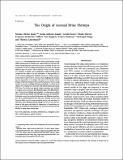Por favor, use este identificador para citar o enlazar a este item:
http://hdl.handle.net/10261/283319COMPARTIR / EXPORTAR:
 SHARE SHARE
 CORE
BASE CORE
BASE
|
|
| Visualizar otros formatos: MARC | Dublin Core | RDF | ORE | MODS | METS | DIDL | DATACITE | |

| Título: | The Origin of Asexual Brine Shrimps |
Autor: | Rode, Nicolas O.; Jabbour-Zahab, Roula; Boyer, Loreleï; Flaven, E.; Hontoria, Francisco CSIC ORCID ; Van Stappen, Gilbert; Dufresne, France; Haag, Christoph; Lenormand, Thomas | Palabras clave: | Polyploidy Automixis Hybridization Contagious asexuality Parthenogenesis Genetic distance |
Fecha de publicación: | ago-2022 | Editor: | University of Chicago Press | Citación: | American Naturalist 200(2): 10.1086/720268 (2022) | Resumen: | Determining how and how often asexual lineages emerge within sexual species is central to our understanding of sex-asex transitions and the long-term maintenance of sex. Asexuality can arise “by transmission” from an existing asexual lineage to a new one through different types of crosses. The occurrence of these crosses, cryptic sex, variations in ploidy, and recombination within asexuals greatly complicates the study of sex-asex transitions, as they preclude the use of standard phylogenetic methods and genetic distance metrics. In this study we show how to overcome these challenges by developing new approaches to investigate the origin of the various asexual lineages of the brine shrimp Artemia parthenogenetica. We use a large sample of asexuals, including all known polyploids, and their sexual relatives. We combine flow cytometry with mitochondrial and nuclear DNA data. We develop new genetic distance measures and methods to compare various scenarios describing the origin of the different lineages. We find that all diploid and polyploid A. parthenogenetica likely arose within the past 80,000 years through successive and nested hybridization events that involved backcrosses with different sexual species. All A. parthenogenetica have the same common ancestor and therefore likely carry the same asexuality gene(s) and reproduce by automixis. These findings radically change our view of sex-asex transitions in this group and show the importance of considering scenarios of asexuality by transmission. The methods developed are applicable to many other asexual taxa. | Versión del editor: | https://doi.org/10.1086/720268 | URI: | http://hdl.handle.net/10261/283319 | DOI: | 10.1086/720268 | ISSN: | 0003-0147 | E-ISSN: | 1537-5323 | Referencias: | Rode, Nicolas O.; Boyer, Loreleï; Flaven, E.; Hontoria, Francisco; Van Stappen, Gilbert; Dufresne, France; Haag, Christoph; Lenormand, Thomas; Jabbour-Zahab, Roula; 2022; The origins of asexual brine shrimps [Software]; Zenodo; Version 2; https://doi.org/10.5281/zenodo.6075087 Rode, Nicolas O.; Jabbour-Zahab, Roula; Boyer, Loreleï; Flaven, E.; Hontoria, Francisco; Van Stappen, Gilbert; Dufresne, France; Haag, Christoph; Lenormand, Thomas; 2021; The origin of asexual brine shrimps [Preprint]; BioRxiv; https://doi.org/10.1101/2021.06.11.448048 |
| Aparece en las colecciones: | (IATS) Artículos |
Ficheros en este ítem:
| Fichero | Descripción | Tamaño | Formato | |
|---|---|---|---|---|
| Asexual-Brine-Shrimps.pdf | 15,3 MB | Adobe PDF |  Visualizar/Abrir |
CORE Recommender
SCOPUSTM
Citations
4
checked on 17-abr-2024
WEB OF SCIENCETM
Citations
5
checked on 24-feb-2024
Page view(s)
37
checked on 24-abr-2024
Download(s)
92
checked on 24-abr-2024
Google ScholarTM
Check
Altmetric
Altmetric
NOTA: Los ítems de Digital.CSIC están protegidos por copyright, con todos los derechos reservados, a menos que se indique lo contrario.
